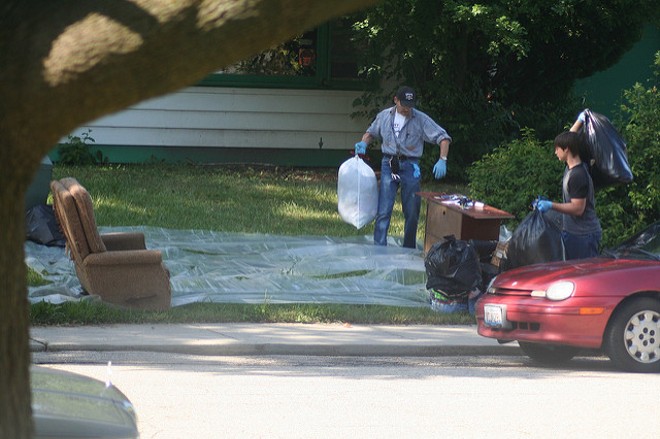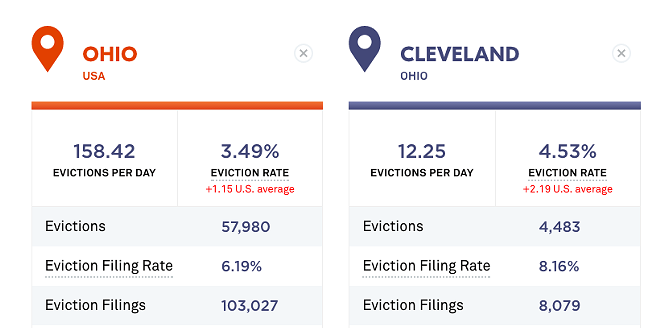There Are An Average of 12 Evictions Every Day in Cleveland. New Data Puts Numbers Behind America's 'Invisible Housing Crisis'
Matthew Desmond's Pulitzer Prize-winning book "Evicted: Poverty and Profit in the American City" was the inaugural choice for One Community Reads, a joint effort in Cleveland between libraries, Playhouse Square, the City Club and Cuyahoga County.
"Not only will One Community Reads bring our residents together through a shared reading experience, but it will give us the opportunity as a community to discuss challenging issues of economic inequality and housing," County Executive Armond Budish said at the launch of the project.
Those challenging issues of economic inequality and housing included not only the systemic and structural issues of eviction (limits on housing vouchers, the dearth of affordable housing, problems with reliable public transportation, discrimination, poverty, tenants being booted for as little as $49 in back-rent) but also the stunning lack of hard data for America's invisible housing crisis.
In reporting out the book, Desmond found there wasn't any nationwide data, so he started the Eviction Lab with Princeton University to tackle the information gap. They recently released the first country-wide data set (for 48 states) after analyzing some 80 million eviction records. The resulting data allows for comparisons across cities, counties, states, and against Census numbers spanning 2000 to 2010.
It is, of course, just a start.
“The breadth and depth of America’s eviction epidemic—and its data trail—requires attention from a wide array of people with different perspectives and skills," Desmond said in an Eviction Lab post. "This is why we’ve adopted an open-source model of data sharing. We need more researchers, city planners, court officers, political leaders, and concerned citizens to join us in filling in the gaps.”
Cleveland averages slightly more than 12 evictions per day, according to the site, with an eviction rate two percentage points higher than the national average.
"These new data are essential for our understanding of eviction in America. Eviction data are notoriously difficult to obtain, especially over time. Some researchers have calculated rates for specific cities for a short period of time, but that often involves combing through court records," says Megan Hatch, an Assistant Professor of Urban Policy and City Management at Cleveland State University's Maxine Goodman Levin College of Urban Affairs who has studied eviction extensively. "Before this, we really did not have a good understanding of the variation in eviction rates across the US. Now that we know the scope of the problem, we can start targeting policies towards reducing evictions and evaluating if those policies are successful."
But, again though, it's just a start. Hatch cautions that these numbers represent only official court filings and judgments. Oftentimes, evictions are achieved through more informal methods, meaning the numbers are actually far higher.
"These data points are low estimates of evictions. They only measure court filings and judgments," Hatch says. "Many evictions happen informally, such as by the landlord threatening eviction, paying the renter to leave, or even changing the locks or calling a health inspector. Therefore, policymakers and the public need to understand the eviction crisis is likely much higher than even what these numbers suggest."
Zooming out from Cleveland proper, a report released this week by the Fair Housing Center for Rights and Research notes there were some 27,696 eviction filings in municipal courts throughout Cuyahoga County in 2016.
It's a daunting number, and one made even more harrowing considering the February closure of the Cleveland Tenants Organization, which had been serving predominantly low-income tenants in the region for more than 40 years, due to lack of funding.
There's a lot to digest here, and a lot for policymakers to pay attention to.
"I think an important point here is that even though rental housing in Cleveland is relatively less expensive than say San Francisco or New York City, we are still experiencing a lot of evictions. Affordability is part of the equation. So is housing quality and the state and local laws that protect renters," Hatch says. "Policymakers should use the data to identify trends, such as if there are increases or decreases in evictions, and target policies towards the areas with the highest eviction rates. As always, however, they need to work with renters themselves, advocates, and scholars for a more complete picture of eviction in a particular area. The new data tell us rates and other important information, but not the qualitative impact those evictions have on renters' lives. When I look at these numbers, I try to remember that each eviction represents a family. The negative impact of evictions on children, families, and communities is huge and lasts a long time."




